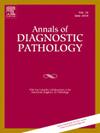原发性骨内Rosai-Dorfman病:临床病理特征和与igg4相关疾病可能关系的评估
IF 1.4
4区 医学
Q3 PATHOLOGY
引用次数: 0
摘要
Rosai-Dorfman病(RDD)是一种罕见的组织细胞增殖性疾病,原发性骨孤立性RDD极为罕见。部分rdd表现出免疫球蛋白(Ig)G4阳性(IgG4+)浆细胞浸润增加和IgG4相关疾病(IgG4- rd)的组织病理学特征。然而,RDD与IgG4-RD之间的关系尚不清楚。因此,本研究旨在探讨原发性骨内RDD与IgG4-RD之间的关系。我们收集了11例原发性骨内Rosai-Dorfman疾病的资料,总结了它们的临床病理特征,并探讨了它们与IgG4-RD的关系。最常见的部位是长骨,其次是椎骨。与文献中报道的西方患者相比,我们中国队列的发病年龄更高,平均年龄为39.2岁,中位年龄为34岁。7例出现硬化症,仅1例出现故事状排列。未见闭塞性静脉炎。每个高倍视野的IgG4+浆细胞数为5 ~ 50个,IgG4/IgG比值为5% ~ 25%。原发性骨内RDD可表现为纤维化和IgG4+浆细胞浸润增加,但不符合IgG4- rd的标准。我们得出结论,RDD不属于IgG4-RD频谱。本文章由计算机程序翻译,如有差异,请以英文原文为准。
Primary intraosseous Rosai-Dorfman disease: Clinicopathological features and an assessment of a possible relationship with IgG4-related disease
Rosai–Dorfman disease (RDD) is a rare proliferative disorder of histiocytes, and primary solitary RDD of the bone is extremely rare. Some RDDs exhibit increased immunoglobulin (Ig)G4 positive (IgG4+) plasma cell infiltration and the histopathological features of IgG4-related disease (IgG4-RD). However, the association between RDD and IgG4-RD remains unclear. Therefore, this study aimed to investigate the relationship between primary intraosseous RDD and IgG4-RD. We collected data on 11 primary intraosseous Rosai–Dorfman diseases to summarize their clinicopathological features and to investigate their relationship with IgG4-RD. The most common sites were the long bones, followed by the vertebrae. The age of onset was higher in our Chinese cohort as compared with Western patients reported in the literature, with an average age of 39.2 and a median age of 34 years. Sclerosis was present in seven cases and storiform arrangement was observed in only one case. Obliterative phlebitis was not observed in any patient. The number of IgG4+ plasma cells ranged from 5 to 50 cells per high-power field, with IgG4/IgG ratios ranging from 5 to 25 %. Primary intraosseous RDD may show fibrosis and increased IgG4+ plasma cell infiltration, but does not meet the criteria for IgG4-RD. We concluded that RDD did not belong to the IgG4-RD spectrum.
求助全文
通过发布文献求助,成功后即可免费获取论文全文。
去求助
来源期刊
CiteScore
3.90
自引率
5.00%
发文量
149
审稿时长
26 days
期刊介绍:
A peer-reviewed journal devoted to the publication of articles dealing with traditional morphologic studies using standard diagnostic techniques and stressing clinicopathological correlations and scientific observation of relevance to the daily practice of pathology. Special features include pathologic-radiologic correlations and pathologic-cytologic correlations.

 求助内容:
求助内容: 应助结果提醒方式:
应助结果提醒方式:


